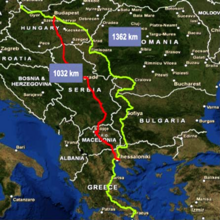Budapest–Belgrade–Skopje–Athens railway
The Budapest–Belgrade–Skopje–Athens railway, a China-CEE "hallmark" project (2014) of Beijing’s Belt and Road initiative,[1] is a planned railroad international connection in Central and Southeast Europe – between Budapest (Hungary), Belgrade (Serbia), Skopje (North Macedonia), Athens and its China-run port of Piraeus (Greece). Planned speed is 200 km/h (120 mph) [2]between Budapest and Belgrade, current line between Thessaloniki and Athens is 200 km/h (120 mph) with upgrades to 160 km/h (99 mph) ongoing.[3] The Chinese planners do not comment on the other tracks' realizable speeds. Originally, they spoke of up to 300 km/h (190 mph) throughout.
The first section, the Budapest–Belgrade railway – a $2.89 billion, 350 km (220 mi) high-speed rail line – should have been finished in two years, but is lagging behind due to an EU investigation into possible violations of its public tendering requirements.[1]
Modernization of the Serbian section[]
In Serbia (some 200 km (120 mi)), one of the segments, the 34.5 km (21.4 mi)-long section Belgrade-Stara Pazova is currently being reconstructed by China Communications Construction Company (CCCC) together with (CRI), with the investment of $350.1 million, funded with a loan from the Export-Import Bank of China,[4][5] this section will be finished by the end of 2020.[6] The section Stara Pazova-Novi Sad is being reconstructed by the Russian RZD International, financed with Russian credit.[5]
The reconstruction of the section Novi Sad-Subotica is set to begin in 2019, with estimated cost of €943 million, built by CCCC[7] and a duration of 33 months, during which this section will be closed.[8] It was announced by Prime Minister Ana Brnabić that the section from Novi Sad to Kelebija will be opened in 2021.[9]
In July 2020, President Aleksandar Vučić announced that the 204km Belgrade-Niš section will be completed by the end 2023. It will have speeds of up to 200km/h (124mph), bringing Belgrade and Niš within 1 hour and 20 minutes of each other.[10] It will follow the direction of the Pan-European Corridor X.
EU planning[]

In a 2012/13 EC report, Priority Project 22: Railway axis Athens–Sofia–Budapest–Vienna–Prague–Nuremberg/Dresden (PP22),[11] the planners included their considerations of the , which follows Pan-European Corridor X through Austria, Slovenia, Croatia, Serbia, North Macedonia and Greece (Thessaloniki–Skopje–Belgrade–Budapest/Zagreb–Ljubljana–Graz/Salzburg) and shortens the present Athens–Budapest route via Bulgaria and Romania by 330 km (210 mi). The total length is around 1,030 km (640 mi) compared to 1,362 km (846 mi) for the current southern Athens–Budapest part of PP22. Moreover, there are also a number of technical advantages of this proposed part of the Balkan route: 89% of it is electrified, as against 75% of the present PP22 route and the tracks are designed for higher maximum speeds overall. Nevertheless 64% of the planned line is still single track, compared to 54% of the present part of the PP22 route.
The planners appeal to the politicians: "In the medium term it may become necessary to tailor priorities in line with what is feasible, both for the European Union, the main provider of funding, and the Member States concerned. In this respect, Croatia’s accession to the European Union in July 2013 and discussions with the [r]epublics of the former Yugoslavia in connection with the review of TEN–T policy present a useful opportunity to develop rail links between south–east and central Europe via the western Balkans."[11]
See also[]
- Trans-European Transport Networks (TEN-T)
- Budapest–Belgrade railway
- Balkan Express (train)
- Bosphorus Express
- Friendship Express
References[]
- ^ a b Another Silk Road fiasco? China's Belgrade to Budapest high-speed rail line is probed by Brussels, by Wade Shepard, Forbes February 25, 2017
- ^ "Who Benefits From the Chinese-Built Hungary-Serbia Railway?". thediplomat.com. Retrieved 1 November 2019.
- ^ China To Finance Construction Of New Budapest-Belgrade Railroad, , December 17, 2014
- ^ "Serbia starts Belgrade-Stara Pazova railway overhaul - govt". seenews.com. Retrieved 4 June 2018.
- ^ a b "Russia's RZD to start overhaul of part of Belgrade-Budapest railway in July". seenews.com. Retrieved 4 June 2018.
- ^ "High speed rail from Belgrade to Stara Pazova by the end of the year". RTS. 5 May 2020.
- ^ "李克强见证匈塞铁路商务合同签署公司应邀参加中国-中东欧国家经贸论坛,孙子宇代表公司签约" (in Chinese). China Communications Construction. 11 July 2018. Retrieved 19 July 2020.
- ^ Hajnalka, Miklós. "Brze pruge i savremene železničke stanice". Magyar Szó Online. Retrieved 4 June 2018.
- ^ "Brnabić: The high speed rail link will allow new opportunities in Subotica". RTS. 10 June 2020. Retrieved 28 July 2020.
- ^ "Vučić: From Belgrade to Niš in an hour and 20 minutes by the end of 2023". RTS. 27 July 2020. Retrieved 28 July 2020.
- ^ a b c Priority Project 22: Railway axis Athens–Sofia–Budapest–Vienna–Prague–Nuremberg/Dresden, Annual Report of the Coordinator, Gilles Savary, European Commission, Brussels, October 2013
- International railway lines
- Rail transport in North Macedonia
- Rail infrastructure in Greece
- Rail infrastructure in Hungary
- Rail infrastructure in Serbia
- Proposed transport infrastructure in Greece
- Proposed transport infrastructure in Hungary
- Proposed transport infrastructure in Serbia
- High-speed trains